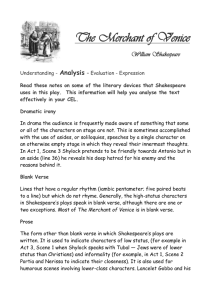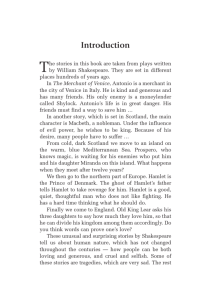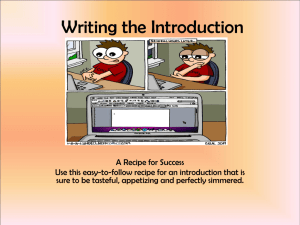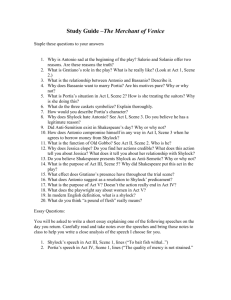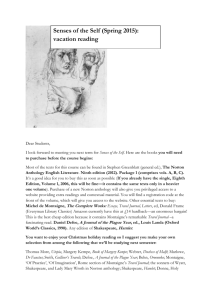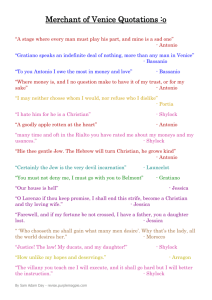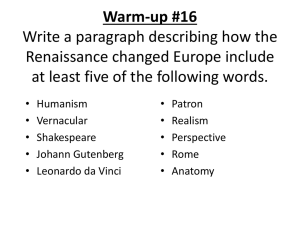The Renaissance
advertisement
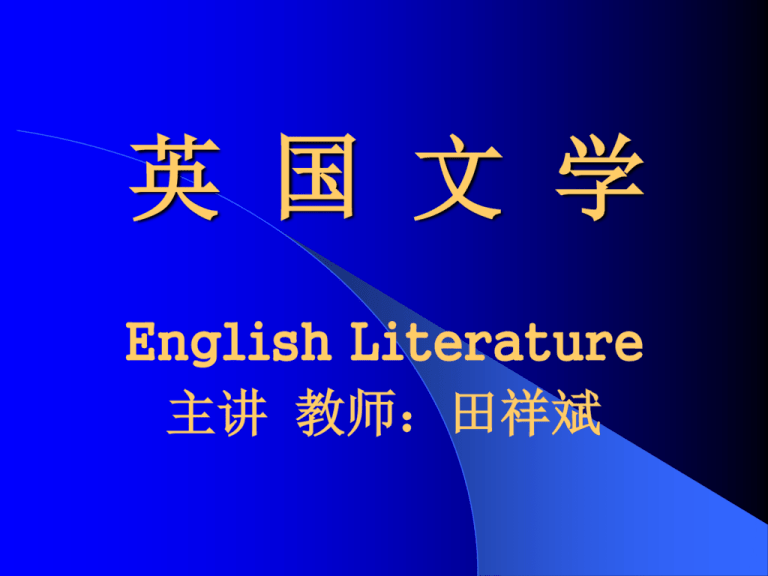
英 国 文 学 English Literature 主讲 教师:田祥斌 English Literature Renaissance and Reformation Lecture IV The Renaissance (1510-1620) I. Historical Background II. English Literature 1. Thomas More (1478-1535) 2. Edmund Spenser (1552-1599) 3. Francis Bacon (1561-1626) 4. Christopher Marlowe (1564-1595) 5. William Shakespeare (1564-1616) 6. Ben Jonson (1572-1637) I. Historical Background I.1 History (1400-1550) The century and a half following the death of Chaucer (1400-1550) was full of significant changes. I.1.1 The Hundred Year’s War with France (1336-1453) I.1.2 The War of the Roses (1455-1483) I.1.3 The New Monarchy was formed in England (Henry VII, 1485-1509) I.1.4 The discovery of America and the new sea routes (1497-98) I.2 16th century I.2.1 The Enclosure Movement (16th century) I.2.2 The Religious Reformation(1509-1547) reform of the Roman Catholic church, which resulted in the establishment of Protestant church in England. HenryVIII (reigned from 1509 to 1547) broke off with the Pope and proclaimed himself head of the Church of England. Absolute monarchy (君主专制政体) in England reached its summit during the reign of Queen Elizabeth (The Elizabethan Age 1558-1603). I.2.3 The Renaissance The Renaissance: The rise of the bourgeoisie soon resulted in an intellectual movement known as the Renaissance, or the rebirth of letters. It sprang first in Italy in the 14th century and gradually spread all over Europe, which reached England slowly in the latter half of the 14th century. Two features are striking of this movement. The one is a thirsting curiosity for classical literature. Old manuscripts were dug out. There arose a current for the study of Greek and Latin authors. Another feature of the Renaissance is the keen interest in human activities. People ceased to look upon themselves as living only for God and a future world. Thinkers, artists and poets arose to the new feeling of admiration for human beauty and human achievement. Hence arose the thought of Humanism. Humanism is the keynote of the Renaissance. Humanism reflected the new outlook of the rising bourgeois class. The greatest of the English humanists was Thomas More, the author of Utopia. The Renaissance is the period of Europe between the 14th and 17th centuries, when the art, literature, and ideas of ancient Greece were discovered again and widely studied, causing a rebirth of activity in all these things. (Longman Dic) The Renaissance is the revival of art and literature in the 14th, 15th and 16th centuries, based on classical forms. (Oxford Dic) The Renaissance was a new growth of interest and activity in the areas of art, literature and ideas in Europe, esp. in Italy, during the 14th, 15th and 16th centuries. (Cambridge Dic.) Humanism: a belief system based on the principle that people’s spiritual and emotional needs can be fulfilled without following a religion. II. English Literature 1. Thomas More (1478-1535) II.1.1 His position: The greatest of the English humanists; “giants” of the Renaissance; a farsighted thinker; one of the forerunners of modern socialist thought II.1.2 His masterpiece: Utopia Genre:humanist essay Author: Thomas More Time: about 16th century Place: in England, Utopia Main Characters: Thomas More, Hythloday Utopia (1516): no place, nowhere a conversation: between More and Hythloday, a returned voyager Book One: contains a long discussion on the social conditions of England and shows us a realistic picture of early 16th century England. Book Two: describes in detail an ideal communist society, the first sketch of an ideal commonwealth, where property is held in common and there is no poverty. Thomas Wyatt (1503-1542) The first great English sonneteer Edmund Spenser (1552-1599) 2. Edmund Spenser (1552-1599) II.2.1 His life: He was born in a minor noble family, his father being a merchant in London. He once received a good education at Pembroke College, Cambridge. In 1599, he died in London and buried beside Chaucer in Westminster Abbey. II.2.2 His major works: The Shepherd’s Calendar (1597). The poem established his reputation as an important poet. Masterpiece: The Faerie Queene (1589, 1596) The Fairy Queen Genre:Poetry Author: Edmund Spenser Type: Narrative Poem Time: Arthur’s Age Place: in England Main Characters: the Fairy Queen signifying Queen Elizabeth; the Redcross Knight Plot and theme: 12 books were to describe the 12 adventures (only finished 6). Each knight represents a virtue, as Holiness, Chastity, Friendship, Justice and Courtesy. It is written in a 9-line stanza form, named Spenserian Stanza. Spenserian Stanza (斯宾塞诗体) : A nine-line stanza consisting of eight lines of iambic pentameter and a concluding line of iambic hexameter, rhyming ABABBCBCC _ named after English poet Edmund Spenser. II.2.3 Characteristics of Spenser’s poetry 1) a perfect melody 2) a rare sense of beauty 3) a splendid imagination 4) a lofty moral purity and seriousness 5) a dedicated idealism. II.2.4 His position: He is known as “the poet’s poet” because of his idealism, his love of beauty and his exquisite melody. He has held his position as a model of poetical art, among the Renaissance English poets. Spenserian Stanza influenced Shelley, Byron, Keats, Tennyson. Spenserian Stanza A 'gentle 'Knight was 'pricking 'on the 'plaine, Ycladd in mightie armes and silver shielde, Where'in old 'dints of 'deepe wounds 'did re'maine, The crell markes of many a bloudy fielde; Yet armes till that time did he never wield; His angry steede did chide his foming bitt, As much disdayning to the curbe to yield; Full jolly knight he seemed, and faire did sitt, As 'one for 'knightly 'giusts and 'fierce en'counters 'fitt. The Fairy Queen is also an allegory; the heroes of the several books represent the virtues portrayed in those books. Allegory – A story with a double meaning: a primary or surface meaning, and a secondary or underthe-surface meaning – A story that can be read, understood and interpreted at two levels Francis Bacon (1561-1626) 3.Francis Bacon (1561-1626) A. His life 1. Associated with the court for his family connections, the boy early won the favor of the Queen. 2. He went to Trinity College, Cambridge University at 12 . 3. He distinguished himself as a scholar in several fields and as a scientist, writer, and philosopher. His practical experience of the world also made him a great lawyer and a considerable statesman. B. His masterpiece The Advancement of Learning, 1605 《学术的 进展》 The Novum Organum 《新工具》(The New Instrument) The New Atlantica 《新大西洋岛》(The New Atlantis) Essays 《论说文集》 C. His position 1. Bacon was an important scientist and philosopher of his time. 1) He is the founder of English materialist philosophy (唯物哲学). 2) Bacon is the founder of modern science in England. 2. He is the first English essayist. Alexander Pope called him, “the wisest, brightest, and the meanest of mankind”, while Ben Johnson declared him to be “one of the greatest man and most worthy of admiration that had been in many ages.” Questions for Of Studies 1. What are the three uses of studies? 2. What are the three abuses of studies? 3. What is the way to remedy the abuses? 4. What instruction does the author give to the reader as to how to read and study? 5. What natural abilities should men have if they don’t study as the author states here? 6. What are the remedies the writer gives the reader for them to get rid of the hindrance and obstacles in their studies and cure the mind? 7. What is the function of the concluding sentence? 8. Which sentence reveals the theme of this writing? Writing Style 1. aphorism (格言警句best-known sayings ) 2. compact and precise in style (文笔简练) 3. clear and forceful in expression (表达明白畅 达,说理充分准确) 4. profound in thoughts( Suggestiveness,思想深邃, 具有 启发性) 5. The sentences are short with more parallelisms and metaphors. 6. Closeness of arguments (论证严密) Christopher Marlowe (1564-1593) 1. Life and career The corner of Old Court of Corpus Christi College, Cambridge, where Marlowe stayed during his studies. 4. Christopher Marlowe (1564 __ 1595) II.4.1 His position a. He is the most gifted of the "University Wits", dramatist. b. He was the greatest of the pioneers of English drama. It is Marlowe who first made blank verse the principal instrument of English drama. His dramatic achievement lies chiefly in his epical, and at times lyrical, verse. c. His works paved the way for the plays of the greatest English dramatist _ Shakespeare II.4.2 His major works Masterpiece: Tamburlaine the Great《帖木儿》1587 The Jaw of Malta《 马 尔 他 岛 的 犹 太 人 》 1592 Doctor Faustus《浮士德博士的悲剧》(The Tragical History of Doctor Faustus.) 1588 University Wits: The name given to a group of English poets and playwrights who established themselves in London in the 1580s and 1590s after attending university at either Oxford or Cambridge. The most important member of the group was Christopher Marlowe, whose powerful blankverse plays paved the way for Shakespeare. Others included George Peele, Robert Greene, Thomas Nashe, John Lyly, and Thomas Lodge. They were all of humble birth and struggle for a livelihood by writing. 5. William Shakespeare (1564-1616) II.5.1 His Life Shakespeare was born in Stratford-UponAvon, in central England. His father, John Shakespeare, was a merchant. His mother, was the daughter of a well-to-do farmer. At the age of 7, he attended the local grammar school and for six years and learned Latin and a little Greek. When he was 14, his father fell into debt, the boy probably left schools, and went to work. At 18 he married Anne Hathaway, who was eight years senior and they had three children. Shakespearean House II.5.2 His position: 1) Shakespeare is one of the founders of realism in world literature. 2)"He is the greatest playwright all over the world, not of an age, but for all the time" (by Ben Jonson). He is also a great poet. Apart from his sonnets and long poems, his dramas are poetry. They are rich in images, conceit, metaphors and symbols. 3) Shakespeare's humanism: he reflects the spirit of his age. 4) Shakespeare's characterization. 5) Shakespeare is the master of the English language. II.5.3 His works 38 plays, 2 long narrative poems, 154 sonnets. II.5.4 Three Periods (or four periods): Shakespeare's works can be divided into three periods: The first period is from 1590 to 1600. In this period, he completed most of his comedies, historical plays, 2 long narrative poems and most of sonnets. Among the outstanding comedies The Merchant of Venice is the best. Other famous comedies are Twelfth Night, A Midsummer Night's Dream, As You Like It. The most famous historical play is “Henry IV”. The second period (1601-1608) is his Period of Tragedies, years of greater achievement. It contains a series of tragedies headed by the famous "Hamlet". These plays reflect the social contradiction of the age (Othello, Macbeth, King Lear). The third period (1609 -1612), in which there are three comedies and a minor historical play. The Tempest is the best in this period. (Cymbeline 1609; Winter's Tale, 1610; The Tempest, 1612) II.5.5 The heroines Three ideal women of the Renaissance and humanism: Portia, Rosalind (in As You Like It), Julia (in The Two Gentlemen of Verona). Shakespeare's heroines are of a new type. They are witty, bold, loving, optimistic and faithful. They are happy and make others happy. They are the daughters of the Renaissance. Romeo and Juliet are images of true love, symbols of faithfulness. They are the children of the Renaissance. II.5.6 Never-to-be forgotten characters: Falstaff; Iago, Desdemona; Shylock; Hamlet; Lear; Macbeth… 1)The Image of Sir John Falstaff He is one of the most brilliant creations in Shakespeare's plays. He is a very complicated character. Falstaff is selfish, treacherous and cynical. He does not hesitate to seek profit whenever there is a chance. Falstaff comes to the battlefield without illusions. He is practical. Honour is a word. Queen Elizabeth was so amused by John Falstaff in "Henry IV" that she ordered Shakespeare to write another play about him. Therefore, Shakespeare wrote his comedy "The Merry Wives of Windsor". In this play, he has been made an ass punished three times, two by the wives of two Windsor townsmen, one by the husbands. He is only a social parasite, moving about with a big belly, eating, drinking and doing nothing. (2)The Image of Othello Othello is a new man of the Renaissance. He is a splendid Moorish general in the service of Venice. He loves Desdemona because she has fine qualities, together with her youth and beauty. They live happily together. But Iago weaves a devilish plot to wreck their love and life. Othello is a tragedy of humanism. He is also a tragedy caused by racial prejudice.(He is black) How to enjoy drama. Crisis Climax (Turning point) ↗ ↘ Complication(s) Falling action ↗ ╲ Conflicts╱ ↘ Resolution Exposition (denouement) II.5.7 Hamlet Genre:drama Author: William Shakespeare Type: tragedy Place: in Denmark Main Characters: Hamlet, Prince of Denmark; Claudius, the dead king’s brother Queen Gertrude, Hamlet’s mother. The selection is Hamlet’s soliloquy. The whole soliloquy is written in blank verse. Soliloquy (独白) A dramatic convention in which a character, alone on stage, speaks aloud and thus shares his or her thoughts with the audience. Or: An act of talking to oneself alone, esp. A speech in a play in which a character’s private thoughts are spoken to those watching the play. (Longman) Blank Verse: A line of poetry or prose in unrhymed iambic pentameter. It is a verse without rhymes, usually in lines of iambic pentameter. Used by Marlowe, Shakespeare, Milton and many other poets, this is the most characteristic English form. Plot: This is the story of murder and revenge. Theme:He condemned the hypocrisy and treachery and general corruption at the royal court, the poet created a man of the Renaissance with humanist ideals who not only sought revenge for his murdered father but aimed to reform the whole society with its many evils. The Character of Hamlet 1)He is a prince loved and respected by everyone. Ophelia says: Hamlet is “The courtier's, soldier's, scholar's, eye, tongue, sword, The expectancy and rose of the fair state. The glass of fashion and the mould of form, The observed of all observers" 2) Hamlet is one of the several Renaissance humanists. “What a piece of work is man; how noble in reason! How infinite in faculty! In form and moving how express and admirable! In action how like an angel! In apprehension how like a god! The beauty of the world! the paragon of animals” 3) He loves good and hates evil. 4) His intellectual genius is outstanding. His image reflects the versatility of the men of the Renaissance. 4. Hamlet's Melancholy (忧郁) Some critics influenced by Freudian view consider that Hamlet is the victim of an Oedipus Complex. Some critics think that revenge is easy, but it is not only personal revenge that Hamlet seeks. What is more important is to expose the roots of the evil and to establish a reign of justice. Sonnet II.5.8 Sonnets ---The sonnet is a poem of 14 lines of iambic pentameter with rigid rime-scheme abab cdcd efef gg (Shakespearean sonnet) ---Sonnet is a lyric poem of 14 lines which follows a fixed rhyme scheme. It's written in iambic pentameter. The two basic types of sonnets are the Italian (or ) Petrarchan and the Shakespearian (or English) sonnets. Two types of sonnets: the Petrarchan (Italian) sonnet and the Shakespearean (English) sonnet. ---a ----b Octet ----b ----a ----a ----b ----b ----a quatrain ----a ----b ----a ----b quatrain ----c ----d ----c ----d ----c ----d Sestet ----c ----d ----c ----d c d e c d e quatrain ----e ----f ----e ----f couplet ----g ----g II.5.9 The Merchant of Venice (1596-7) Genre:Drama Author: William Shakespeare Type: Comedy;Romantic Comedy Place: Italy Main Characters:Shylock, a money-lender, a usurer; Antonio, a Christian merchant; Bassanio, a young man who is the dear friend of Antonio; Portia, a beautiful girl who is the heroine. Conflicts: Antonio and Shylock, merciful Portia and heartless Shylock (two central characters) the Duke and Shylock, Bassanio and Shylock, Gratiano and Shylock, Bassanio and his personal responsibility, Bassanio and his ring. This scene can be divided into four parts 1. Shylock's coldness and cruelty before the Duke and Bassanio; 2. Portia tries to persuade the Jew to show mercy to Antonio, but Shylock remains indifferent; (climax) 3. Portia uses her quick wit to save Antonio's life. Symbol: 4. The problem of whether Bassanio should reward the lawyer with his precious ring. (The play returns to romantic comedy.) The theme: The central theme of the play is obviously the triumph of love and friendship over greed and brutality, good over evil, and humanity over inhumanity. The playwright praises the friendship between Antonio and Bassanio and idealizes Portia as a heroine of great beauty, wit and loyalty. The author condemns the usurer Shylock. Major Themes – Traditional: To praise the friendship between Antonio and Bassanio, to idealize Portia as a heroine of great beauty, wit and loyalty to her husband, to expose the greediness of the Jew – Modern: To satirize the Christians’ hypocrisy and their false standards of friendship, love, kindness, and their cunning ways of pursuing worldliness; to expose the unreasoning prejudice of the Christians against the Jew Other Themes – (1) Love and Wealth – (2) Mercy Vs. Revenge – (3) Harmony – (4) Friendship General Character Analysis 1. Shylock a Jewish moneylender; a revengeful Jew; a merciless villain and also a comic butt; a greedy usurer; a tragic victim of Christian cruelty. 2. Portia Portia embodies the best qualities of Shakespeare's ideal of the new women __a daughter of the Renaissance. (beauty, wit, intellect, virtue, charity) She is charming, intelligent, merciful and virtuous. She is honorable, but she remains a playful and tender wife. 3. Antonio Antonio is the merchant, who is a rich and highly respected citizen in Venice, possessed of many friends. By nature, he is a melancholy man, a silent and reflective gentleman who values friendship more than anything in the world. 4. Bassanio Bassanio is a friend to Antonio and later husband to Portia, who is also a noble, generous, and honorable young man. E. Questions 1. Is Shylock cruel? If so, what develops his cruelty? 2. What do you think of Portia? 3. How does Portia perform to push the conflicts to climax? 4 What is the theme of the play? II.5.10 Shakespeare’s Major Ideas 1. Humanistic ideas He is against religious persecution and racial discrimination. He is against social inequality and the corrupting influence of gold and money. He finds no way to solve the social problems. At last, what he can only do is to escape from the society to seek comfort in his dream. 6 Ben Jonson (1572--1637)dramtist 1. His life and position 1) He never attended a university. 2) "Rare Ben Jonson” He was known as "Rare Ben Jonson", a quarrelsome man, but fearless and honest. He has left plays, poems and prose. Ben Jonson is a collection of notes and ideas on various subjects. 3) He is the father of English literary criticism. Jonson says that a critic ought to judge a work as a whole, and that the critic himself must have some poetic abilities. A play should be realistic, showing “an image of the times”. His critical ideas are not limited to this book, but appear elsewhere. Masterpiece: Volpone (1605-6, printed 1607)
